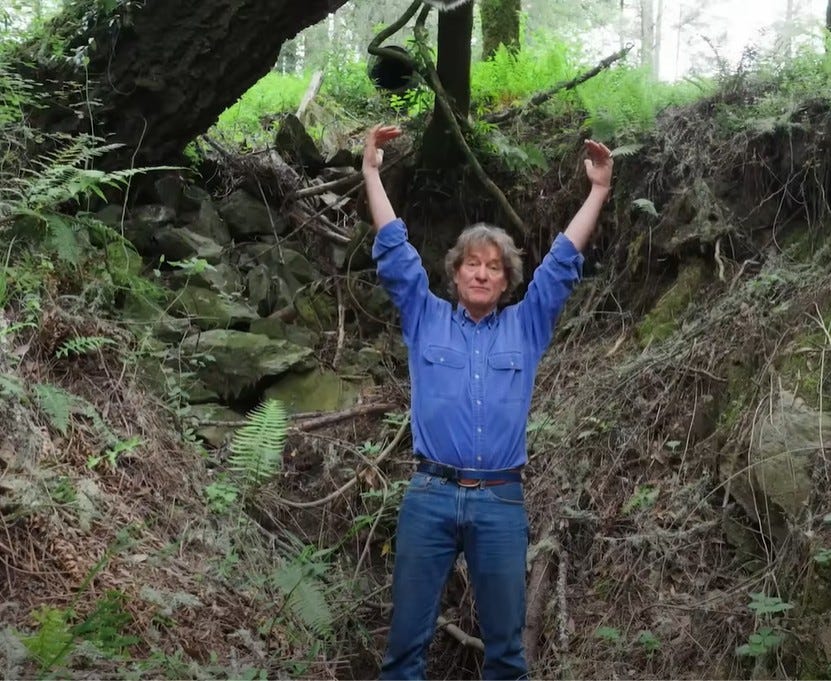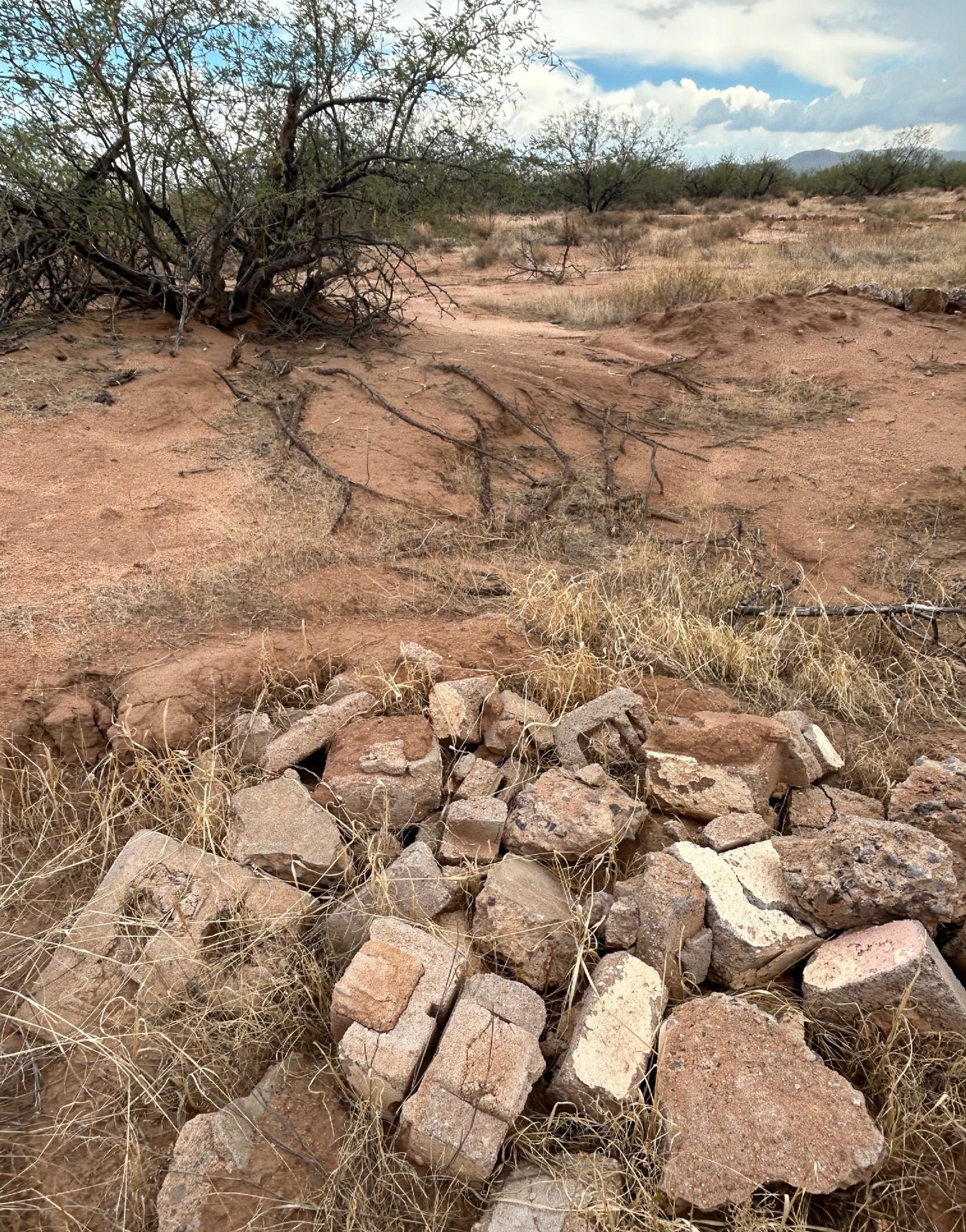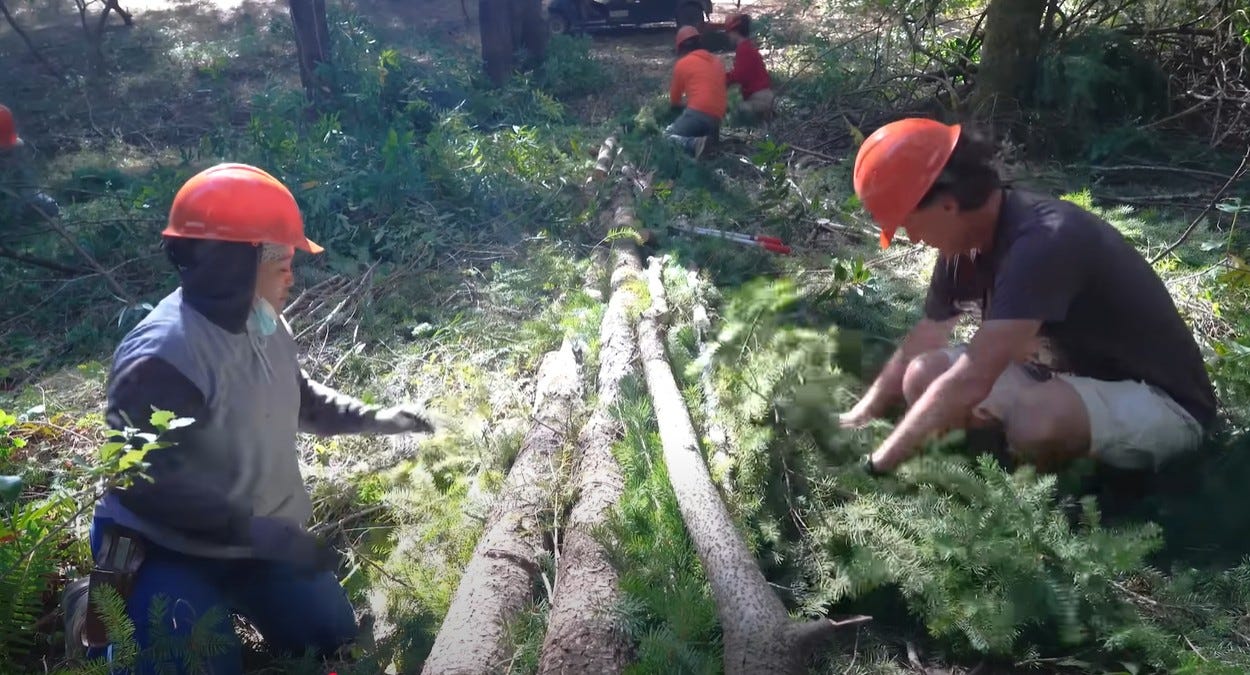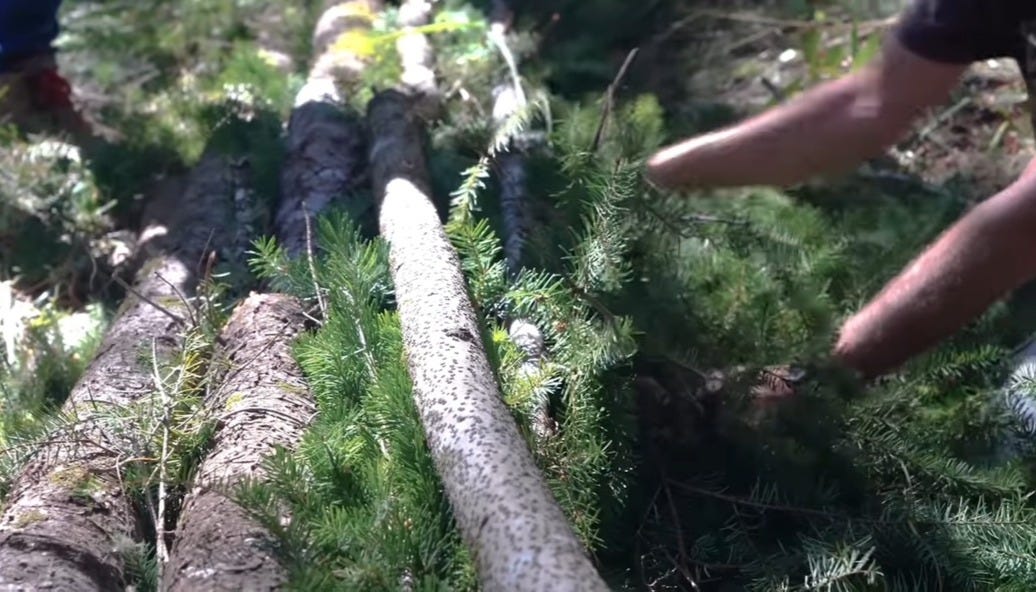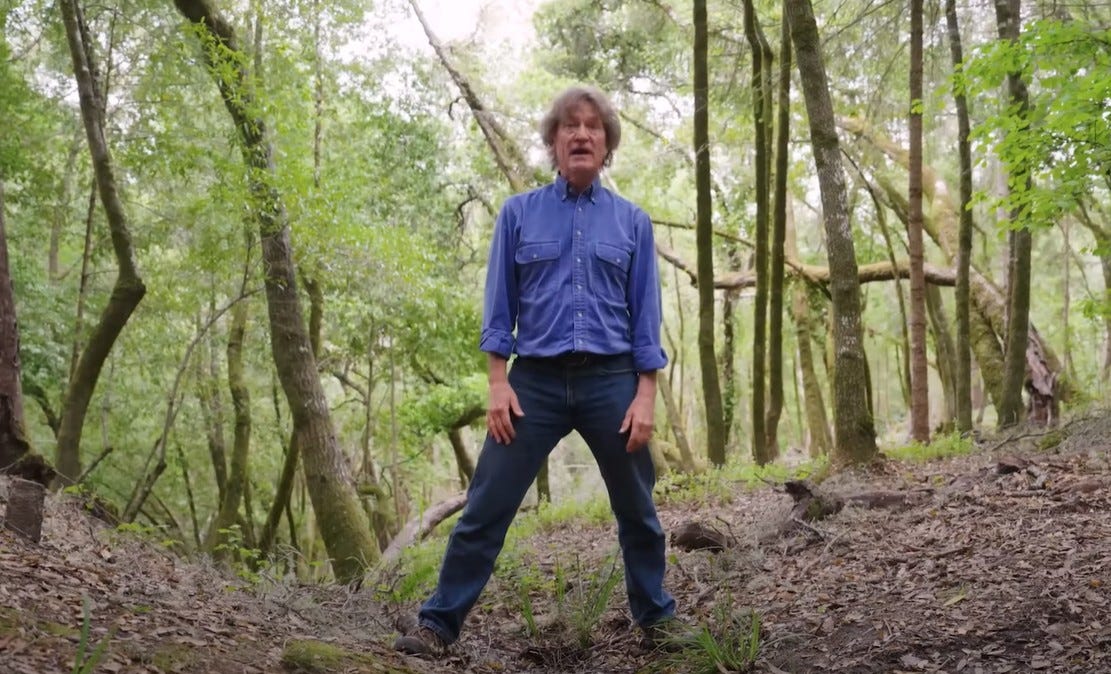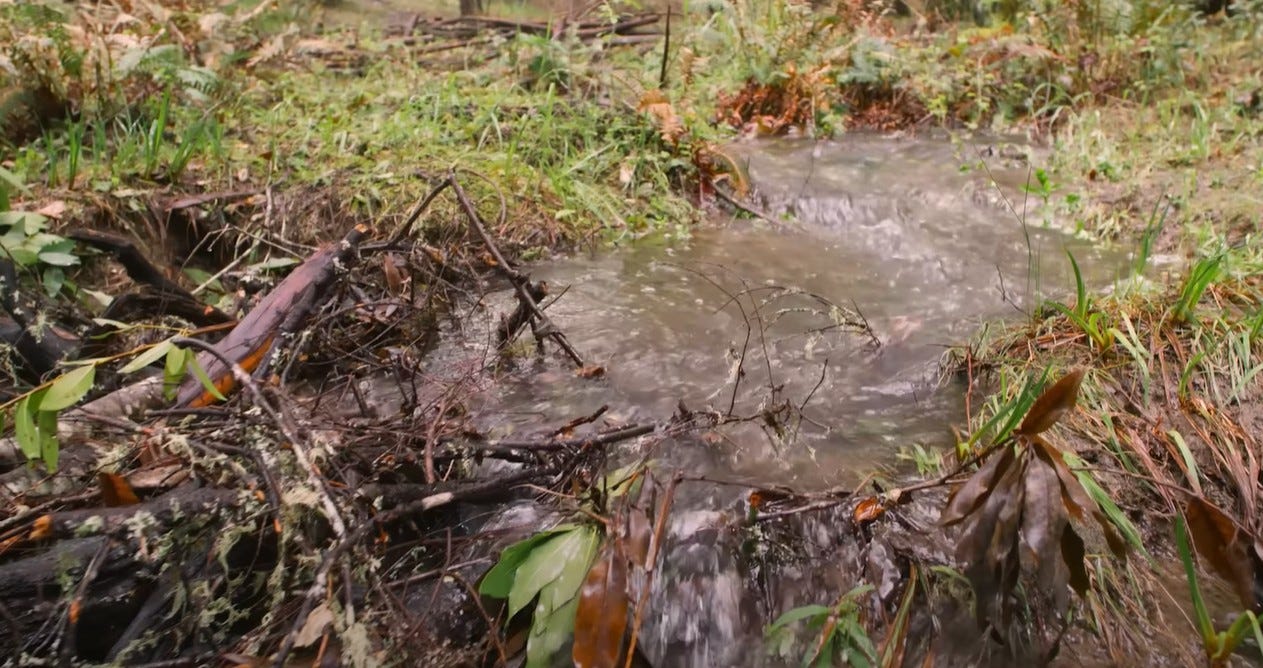Brock Dolman stands in a California gully before it’s been repaired. Image from a video and used with permission.
After my spouse and I moved to an undeveloped parcel of land outside of Tucson about a decade ago, we found the occasional heavy rains were creating gashes on the landscape. In these gullies, tree roots faced the glare of sunshine. We worried the next big rain might topple some of the smaller mesquite trees.
I tried a standard water-harvesting practice to address this. We laid down a series of crescent-shaped lines of rock ranging in size from softballs to not quite basketballs to stretch across the gully and slow down the flow of water.
Slowing the water down can nudge it into dropping some of the soil particles it’s carrying. This can reverse the erosion as the soil left behind piles up.
In our case, the rock check dams did help a bit. At least the bankside trees no longer verged on being torn out of the anchoring soil. But roots remained exposed.
Check dams placed in some gullies where I live helped slow the water down to lessen the risk of future erosion. But it did little to fill in the gaps already there. Photo by Melanie Lenart
I longed for a better solution.
After sitting in on a Biodiversity for a Livable Climate course presentation by Brock Dolman of California’s Occidental Arts and Ecology Center, I may have gotten my wish. The ideas he shared on “gully stuffing” just might work here.
The technique, described in more detail further below, involves collecting small trees, limbs and/or brush and placing them in a structured way into a specific gully.
At any rate, it’s a system he’s used successfully in smaller streambeds for more than 35 years. So, with Dolman’s encouragement, I’m sharing some of information on the process based on his presentation in a virtual session of the Water and Climate course and the Occidental center’s excellent 16-minute video, “How to Stuff a Gully.”
Participants in a workshop arrange thinned trees and other brush into a protective layer to top off a stuffed gully. Image from a video and used with permission.
Solving both ‘fire fears and water woes’
Between logging, overgrazing, altered climate and wildfires, our landscapes have been taking a beating in recent decades. In many places, the removal of the trees and grasses has dried up soil and waterways. Along with decades of suppressing fire, it’s also made forests more flammable.
What’s more, the resulting soil erosion can lead to the deep gashes we call gullies.
Dolman has seen plenty of those on the Occidental center’s 80-acre site in California, thanks to a legacy of logging the biggest trees starting in 1880s. Located in an upland area that drains into Sonoma County’s Russian River, the center sported gullies 10 feet deep in places.
Gully stuffing, however, tackles both “fire fears and water woes,” he notes.
Collecting the brush makes the forest more resilient to wildfire. Using that brush to build up land scarred by sunken waterways, meanwhile, improves both the quality and retention of the resulting water.
Although this technique typically applies to the kinds of steep slopes that beavers won’t tolerate, the approach adapts beavers’ use of wood and leafy branches to build structures that encourage water to linger on the landscape, as I wrote about Tuesday. Dolman even teaches an annual course in October called “Build Like a Beaver.” (Sorry, the 2025 course is already full.)
This process-based restoration differs from the logging projects the current Republican administration calls “thinning.”
“Increasingly, what we're witnessing, especially in the Sierra Nevada, is a complete industrial mindset and justification for logging under the guise of fire, resiliency, and/or salvage logging post burn,” Dolman told course participants. “And when I'm invoking ‘thinning,’ I'm not invoking industrial, commodified extraction practices.”
The thinning work keeps nature, not profit, in mind.
It saves fossil fuel energy by keeping the slash on site instead of carting it off for burning or chipping. Keeping the carbon and nutrients in the wood on site nourishes the ecosystem as compost. And what Dolman calls “plugging the drain” of water leaking downstream allows rain to spread out and reach more trees.
Layers of green leaves and “brown” wood turn into compost over time. Image from a video and used with permission.
A recipe for gully stuffing
“Thinning and limbing,” as Dolman describes it, involves harvesting the surrounding dense brush to remove some of the small trees that can convert into kindling an intensify western wildfires.
Workshop participants also trim some of the lower tree limbs. The latter can also carry fire into the crowns. Ponderosa pines, for instance, have an adaptation of dropping their lower limbs over time, often after surviving fire.
Some of the branches with leaves become what Dolman calls “green gauze.”
“When you have a bleeding wound, which is what a gully is on the land—it’s bleeding sediment—you want to staunch that bleeding, you put on a gauze bandage,” he says in the video.
The leafy layer forms a slightly depressed U-shape that keeps the center lower than the sides.
Then comes a layer of heavier “brown” material, such as leaf-free branches. The occasional bigger branch or log goes in too, to serve as “rebar” to hold things together. Participants weave in other layers of green material.
Finally, the heaviest wood goes on the top to hold everything down. If needed, vertical posts can help hold the upslope material in place.
“It's like making a lasagna. It's making a compost pile. There's green, brown, green, brown, green, brown,” Dolman said. “And then the water shows up when it rains and kicks off the composting process.”
Years later, the gully becomes almost imperceptible on the landscape. When it rains, though, it moves slower than before. Water that is purified by the organic material below in what amounts to a carbon filter can spread out across the land.
Those interested in experimenting with this technique should review the video and Occidental’s Fuels to Flow program resources and, as Dolman reminds, don’t forget to get the necessary permits from regulatory agencies. Also, expect to do some maintenance for the first couple of years.
Brock Dolman stands where a deep gully once gouged the land. Image from a video and used with permission.
Do try this at home, folks
It surprised me that I hadn’t previously been aware of the gully-stuffing technique, given that I co-taught a Water Harvesting course at University of Arizona. We focused on the urban environment, though, where overflow from streets is a focus, not the gullies found mainly in rural areas.
Still, I did go back to the book we used for the course, Brad Lancaster’s Rainwater Harvesting for Drylands and Beyond, to see if I had overlooked the mention of gully stuffing. I didn’t find anything in Volume 1, the book we used in the class.
But in Lancaster’s Volume 2, I found an image showing “brush-rill repair”—and it was from Occidental.
The same short passage featured a brush check dam designed by the Southwest’s Zuni Tribe. It was from a 2002 journal article on “Native American Methods for Conservation and Restoration of Semiarid Ephemeral Systems,” written by western scientists and Zuni farmers.
Delighted to find the Journal of Soil and Water Conservation article was free, I noticed the Zuni system is designed for smaller gullies in lowlands. So, this resource also could also prove relevant to my own future efforts to repair the gullies scarring the land we steward.
I’m excited to apply the knowledge gained, perhaps this fall after we prune our mesquite trees.
Even if you don’t live near gullies that could benefit from this technique, the professionally done video is worth watching.
It’s not everyday you get to see gaping holes restored into purified streams.


